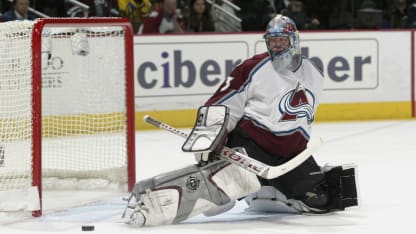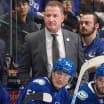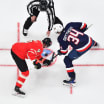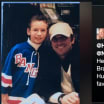More than anything, though, Roy was a fierce and feisty competitor who had an undeniable gift for being at his best when it mattered most. It wasn't for nothing that Canadiens fans started calling him "Saint Patrick" after he led the Canadiens to the Stanley Cup in 1986 at age 20, putting up a 1.92 goals-against average in 20 playoff games to become the youngest Conn Smythe winner.
He was no less heroic a year earlier during a championship run by the Sherbrooke Canadiens of the American Hockey League. Bring on the pressure, and watch Roy turn into a butterfly-style world-beater, pads splayed, body coiled, stick flashing.
"I always said if I had to play one game and I had the choice of anyone in NHL history to play goal for me, I'd pick Patrick Roy, because whenever the stakes were biggest is when he played his best," ESPN hockey analyst Barry Melrose said. "That's a tribute to a great athlete."
PATRICK ROY CAREER TOTALS | View Full Stats
Games: 1,029 | Wins: 551 | Losses: 315 | Ties: 131 | GAA: 2.54
Glenn Hall is generally acknowledged as the father of the butterfly style of goaltending, and Tony Esposito was perhaps his most successful disciple. But nobody in his era did more to popularize it than Roy, not only because of his spectacular results but because of his outsized personality and swagger, and his own quirky hybrid of combativeness and charisma. Shortly after Roy retired, he was asked by a Sports Illustrated writer which shooters he feared the most over his 18-year career.
"To be honest with you, there's none," Roy said.
Roy famously winked at Tomas Sandstrom after making a sparkling save against him in the heat of a playoff game against the Los Angeles Kings. He once tangled with a teammate, Mathieu Schneider, between periods, and had an infamous mid-ice fight with a fellow goaltender, Mike Vernon, in the midst of a free-for-all in the heyday of the bitter Colorado Avalanche-Detroit Red Wings rivalry.
Sometimes after snaring a shot, Roy would hold his glove hand aloft, a freeze-frame moment that didn't endear him much to his opponents.
All of this made Roy compelling theater between the pipes, and made a whole generation of kids in French-speaking Canada want to play goalie and be like Patrick, among them Jean-Sebastien Giguere, Jose Theodore and Roberto Luongo.
"He'll be talked about as long as they're playing hockey," Ray Ferraro told ESPN.
A center who had an 18-year NHL career of his own, Ferraro got an up-close glimpse of Roy's brilliance in the seven-game showdown between Ferraro's Hartford Whalers and the Canadiens in the Adams Division Finals in 1986. Montreal won on Claude Lemieux's overtime goal and with the help of 24 saves from Roy, going on to take the conference final (against the New York Rangers) and the Stanley Cup Final (against the Calgary Flames) in five games each.
"Some goalies can get into players' heads," Ferraro said. "Well, Patrick was so good you were more concerned about him than you were about getting to the net a lot of times. In '86 -- when he won the Cup as a rookie and he beat us in overtime in (that) Game 7 -- he was so good. And no one knew anything about him."
Roy grew up in Quebec City, rooting for the Nordiques before being selected in the third round (No. 51) by the Canadiens in the 1984 NHL Draft -- 50 picks after the top selection, Mario Lemieux, with whom he shares a Hall of Fame pedigree, as well as a birthday (Oct. 5, 1965). Roy's good fortune was to be assigned to Sherbrooke, where his goaltending coach was Francois Allaire, a noted expert in the butterfly style and a man regarded as one of the preeminent goaltending tutors anywhere.
"I was hungry to learn and soak up as much as I could, and he loved to teach," Roy told The Denver Post. "It was, to me, a perfect fit."
Roy did not have a standout rookie year in 1985-86, when he went 23-18-3 with a 3.35 goals-against average and an .875 save percentage. Then came the Stanley Cup Playoffs, and suddenly Roy was stopping everything this side of traffic outside Montreal Forum. In 20 games, Roy faced 506 shots and turned away 467 of them -- a save percentage of .923. His record was 15-5.
Certainly the Canadiens got huge contributions from captain Bob Gainey and Larry Robinson, and 10 goals from Claude Lemieux, but center Bobby Smith said the biggest difference-maker was their goaltender.
"I was right there in '86 and his performance was unbelievable," Smith said. "I don't think anyone ever said Patrick did it by himself -- and I don't think Patrick would ever say he did it by himself -- but we wouldn't have won in '86 without having the goaltending that Patrick gave us."
Roy would soon establish himself as one of the elite goaltenders in the game, posting records of 33-5-6, 31-16-5, 25-15-6 and 36-22-8 between 1988 and 1992, capturing the Vezina Trophy three times as the NHL's top goaltender in that span. He reprised his rookie dominance in 1992-93, carrying a third-place Canadiens team to another Stanley Cup title, his 2.13 GAA and 16-4 record earning him another Conn Smythe honor. Roy won an astonishing 10 straight overtime games in the 1993 playoffs. With No. 33 in the net, anything seemed possible.
And then the unthinkable happened.
The date was Dec. 2, 1995. The Canadiens were hosting the Detroit Red Wings. Detroit scored five goals in the first period against Roy, then four more in the second before Canadiens coach Mario Tremblay, a former teammate of Roy's, finally pulled him. It was so bad that the hometown fans cheered when Roy made even an easy save. As he made his exit from the goal, Roy skated toward the bench, brushed right past Tremblay and stomped over to team president Ronald Corey, who was sitting right behind the bench.
Roy told him he had played his last game with the Canadiens.
Four days later, what is widely regarded as the worst deal in Canadiens history was consummated; Roy and Mike Keane went to Colorado for Andrei Kovalenko, Martin Rucinsky and Jocelyn Thibault. It became known as Le Trade in Montreal, and the wound has never fully closed.
Roy was certain that at 30 he had plenty of prime years remaining, and he didn't need to wait long to prove it, helping the Avalanche (formerly the Nordiques team he grew up rooting for) win the Stanley Cup title in that same 1995-96 season -- the franchise's first year in Colorado.
Keane could sense it was coming.
"[Roy] is hungry to prove a lot of people wrong," Keane told The Denver Post. "When Patrick says he's hungry, you know he's going to play up to another level and that could be scary."
Roy won his fourth and final Cup title five years later, and may have been better than he had ever been. In winning 16 games, he had a goals-against average of 1.70 and a save percentage of .934. With the Avalanche trailing the series against the New Jersey Devils 3-2, Roy recovered from a giveaway that essentially gifted Game 4 to the Devils, shutting out New Jersey in Game 6 and allowing one goal in Game 7, a 3-1 triumph that assured Roy of yet another Conn Smythe.
Before Game 6, Roy told Colorado coach Bob Hartley, "It's your job to figure how to get us a goal because I'm not letting in any."
Roy was good to his word, and when he retired two years later, he did so with NHL records for most regular-season victories (551), games played by a goalie (1,029), playoff victories (151), playoff games played (247) and playoff shutouts (23). He also departed, in the minds of many, as arguably the best money goaltender in NHL history. Roy, a 2006 Hockey Hall of Fame inductee, said his concern has never been about his place in history, but about doing everything possible to "get that big silver thing" into our arms at the end of June.
Patrick Roy accomplished that goal four times. Some will argue that Terry Sawchuk was the greatest goaltender. Others will go with Jacques Plante, or Martin Brodeur, or Dominik Hasek. The debate will go on forever. Rob Blake, an Avalanche defenseman who played in front of Roy, told Sports Illustrated who is getting his vote.
"In a must-win game," Blake said, "there'd be no goalie you'd take ahead of Patrick."
For more, see all 100 Greatest Players


















